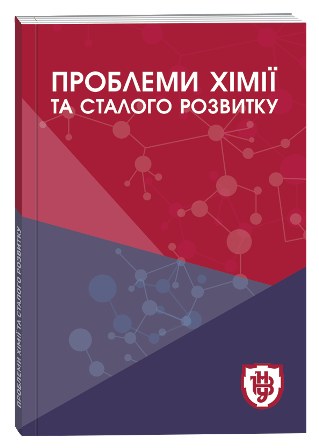POTENTIOMETRIC SENSOR FOR THE DETERMINATION OF SCOPOLAMINE
DOI:
https://doi.org/10.32782/pcsd-2024-1-2Keywords:
scopolamine-selective sensor; potentiometry; determination of scopolamineAbstract
The development of applied potentiometry requires both theoretical research, invested in elucidating the nature of the selectivity of electrode membranes, and the search for new methods of membrane synthesis and its modification in order to obtain more perfect structural units with a wider range of functional properties of these materials. To solve this problem, an important role is played by establishing a connection between the structural characteristics of the membranes and their influence on the electroanalytical properties. The interaction of the organic scopolamine cation (Skop+) with erythrosine (ER-) was investigated. The energy efficiency of the formation of IA was substantiated by the method of mathematical modeling. Molecular modeling of Scop+ + ER- systems and related calculations were carried out using the HyperChem 8.0 package for various initial options for the arrangement of counter ions relative to each other ("single point" procedure). Geometrical optimization of ions was carried out using the MM+ molecular mechanics method. A scopolamine-selective sensor with a plasticized polyvinyl chloride membrane was developed. The electrode contains the ionic associate of scopolamine with erythrosine. To model the composition of the membrane, PVC was used as a matrix; investigated membranes plasticized with dibutyl phthalate (DBP), diethyl phthalate (DEP), dioctyl phthalate (DOP), dinonyl phthalate (DNP), dibutyl sebaceate (DBS), tricresyl phosphate (TCP). It was established that the nature of the plasticizer somewhat affects the steepness and to some extent the detection limit of the sensors. The response is linear within the range of scopolamine ion concentration change of 1·10–5 – 1·10–1 mol/l with a slope of the electrode function of 55.2 ± 1.0 mV/pС. The sensor has a short response time of 6-10 s and can be used for at least 10 weeks. Sensors with a higher content of plasticizer work longer than with a lower content. The electrode can be used in the pH range of 3.0- 7.0. Selectivity coefficients for scopolamine with respect to potentially interfering ions were investigated. To evaluate the developed sensors, they were tested for the determination of scopolamine in various objects by the method of ionometry and potentiometric titration.
References
Putcha L., Cintrón N. M., Tsui J., Vanderploeg J. M., Kramer W. G. Pharmacokinetics and Oral Bioavailability of Scopolamine in Normal Subjects. Pharmacology Research. 1989. Vol. 6 (6). P. 481–485. DOI:10.1023/A:1015916423156.
Juo P.S. Concise Dictionary of Biomedicine and Molecular Biology (2nd ed.). Hoboken: CRC Press. 2001. p. 570. ISBN 9781420041309.
Fischer J., Ganellin C.R. Analogue-based Drug Discovery. John Wiley & Sons. 2006. p. 551. ISBN 9783527607495.
Raetsch C. The encyclopedia of psychoactive plants: ethnopharmacology and its applications. US: Park Street Press. 2005. pp. 277–282.
World Health Organization. World Health Organization model list of essential medicines: 21st list 2019. Geneva: World Health Organization. 2019. 60 p. WHO/MVP/EMP/IAU/2019.06. URL: https://iris.who.int/handle/10665/325771.
Chen J., Lu A., Tan D., Zhang Q., Lu Y., Qin L., and He Y. Determination of Scopolamine Distribution in Plasma and Brain by LC-MS/MS in Rats. International Journal of Analytical Chemistry. 2022. Article ID 8536235, 9 p. https://doi.org/10.1155/2022/8536235.
Jornet-Martínez N., Herraez-Hernandez R., and Campíns-Falco P. Scopolamine analysis in beverages: Bicolorimetric device vs portable nano liquid chromatography. Talanta. 2021. Vol. 232. 122406. https://doi.org/10.1016/j.talanta.2021.122406.
Brown K., Jacquet Ch., Biscay J., Allan P., and Dennany L. Analyst. 2020. Vol. 145, РР. 4295–4304. DOI: 10.1039/d0an00846j.
Mostafa G.A.EH. Potentiometric PVC Membrane Sensor for the Determination of Scopolamine in Some Pharmaceutical Formulations. Analytical Sciences. 2002. Vol. 18. PP. 1335–1338. https://doi.org/10.2116/analsci.18.1335
Кормош Ж., Шевчук М., Кормош Н., Люшук К., Корольчук С., Савчук Т., Юрченко О., Піскач Л., Боркова С. Потенціометричний сенсор для визначення нафазоліну. Проблеми хімії та сталого розвитку. 2023. № 3. С. 20–25. DOI: https://doi.org/10.32782/pcsd-2023-3-3.
Кормош Ж., Шевчук М., Кормош Н., Люшук К., Корольчук С., Савчук Т., Юрченко О., Піскач Л. Потенціометричний сенсор для визначення левамізолу. Проблеми хімії та сталого розвитку, 2023. № 2. С. 3–9. DOI: https://doi.org/10.32782/pcsd-2023-2-1.
Kormosh Zh., Kormosh N., Golub S., Pachenko Yu., Yurchenko O., Savchuk T., Korolchuk S., Borkova S., and Suprunovich S. New potentiometric sensor for determination of metformin. Pharmaceutical Chemistry Journal. 2022. Vol. 56. No. 8. pp. 1140–1143; DOI 10.1007/s11094-022-02765-1.
Kormosh Zh., Kormosh N., Lyushuk K., Semenyuk O., Kotsar V., Osyp Yu., and Savchuk L. Spectrophotometric determination of flurbiprofen in application to pharmaceutical analysis. Pharmaceutical Chemistry Journal. 2022. Vol. 56. No. 7. pp. 999–1003. DOI 10.1007/s11094-022-0274.
Kormosh Zh., Khalavka Yu., and Mittal S. K. Design and application of potentiometric sensors for the determination of mefenamic and phenylanthranilic acids. Analytical Methods. 2023. Vol. 15. PP. 1903–1914. https://doi.org/10.1039/D2AY02092K.
Kormosh Z., Gorbatyuk N., Kormosh N., Shevchuk M., Liushuk K., Kotsar V., Bokhan Yu., and Borkova S. Novel Potentiometric Sensor for the Determination of Ibuprofen. Pharmaceutical Chemistry Journal. 2023. Vol. 57. N 5. PP. 745–749. https://doi.org/10.1007/s11094-023-02946-6.
Програма MarvinScetch. [Електронний ресурс]. – Режим доступу: http://www.chemaxon.com.







